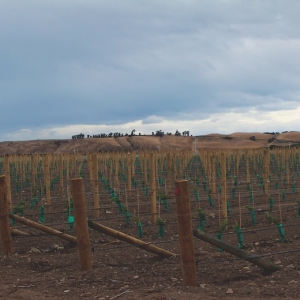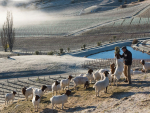Acccording to the latest NZW Vineyard Register, there are 22,819ha of productive vineyard land in Marlborough, which is 65 percent of the country’s total. The accepted belief is that there is roughly only a few thousand hectares of bare land left suitable for winegrowing. Even some of that may be conditional on weather, soil types and the availability of water.
Which may explain why wine companies are racing to purchase or lease suitable properties and get grapes in the ground as soon as possible. Delegats, Indevin, Marisco, Ara and a number of medium size wineries, were busy planting out last year, with the Vine Nursery Survey showing deliveries of 1,739,898 vines into Marlborough.
If you use the ratio of 2222 vines per hectare, that equates to the equivalent of 783 hectares of new planting in one year alone.
This year the forward orders are for 2,508,054 vines for Marlborough, which on the same ratio as above equates to 1,128 hectares of plantings.
(Admittedly, many of these vines will be for replants, not just new developments.)
Given the anecdotal talk that only a few thousand hectares are left to grow grapes in Marlborough, it would appear that most of that is already earmarked. Especially when you consider two of the biggest tracts of bare land in the region are owned by either Marisco Wines or Ara.
Marisco, owned by Brent Marris, bought the 2000ha Leefield Station back in 2012. A large part of the property is unsuitable for vines, but at least 500 hectares are expected to be planted out between now and 2018.
Ara, which was the former Bankhouse Station, covers a total of 1500 hectares, and only a third of that has been planted, with much more to come.
Other major companies such as Indevin and Constellation are also committed to expansion and while some big players didn’t want to discuss their plans, there are indications most are looking at increasing holdings. Some of that may be through acquiring established vineyards.
The expansion is riding on the back of the region’s flagship variety Sauvignon Blanc, which continues to be the country’s major export. More than a billion glasses are poured every year and this one variety makes up $1 billion of New Zealand’s $1.3 billion in wine exports.
Dave Stark, registered valuer at Alexander Hayward in Marlborough said the plantings are a solid indication of how much more confidence there is in the wine industry in the region.
“These new plantings are the first we have seen since 2008. It’s a sign that people are feeling more confident and for the best part, it is not based on speculation. These plantings have been undertaken by major, established wine companies with markets for wine.”
So is there any room to move in Marlborough – is there some chance that the region will expand further south, or has it reached saturation point? That may well be the $1 billion question. While some small parcels of suitable land are available in the Wairau Valley, the large tracts have all gone. There are some larger blocks available in the Awatere. But water is always going to be an issue there.
The one hope for those looking at expanding further south past Seddon, is the proposed Flaxbourne Community Irrigation Scheme. If this goes ahead it will open up an area estimated to be 2,200 hectares – with a portion of that suitable for grapes.
After that, there may be very little chance of Marlborough expanding further – unless global warming takes a hold earlier than expected. ν
This email address is being protected from spambots. You need JavaScript enabled to view it.












